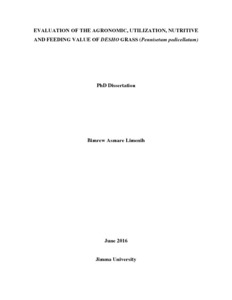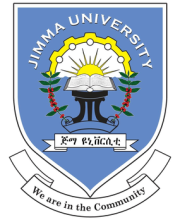Resource information
This study comprised of field survey, agronomic trial, laboratory and animal evaluation of desho grass. A total of 240 households (hh) were involved in the field survey conducted to assess the status of desho grass production and utilization in Burie Zuria and Doyogena districts, with the use of pre-tested and semi- structured questionnaire. The grass was planted at mid and highland altitudes using vegetative root splits in randomized complete block design to determine the effects of altitude and harvesting dates (90, 120 and 150 days after planting) on morphology, dry matter (DM) yield and chemical composition of desho grass. Feeding & digestibility trials were conducted using 25 Washera yearling rams with mean body weight of 19.4+1.89 kg in randomized complete block design to evaluate the feed potential of desho grass as a basal diet. The dietary treatments studied were; 100% Natural Pasture Hay (NPH) (T1), 75% NPH+25% Desho Grass Hay (DGH) (T2), 50% NPH + 50% DGH (T3), 25% NPH+75% DGH (T4), and 100% DGH (T5). All the treatment groups were supplemented with 300 g/h DM of concentrate & data on feed intake, daily body weight gain, feed conversion efficiency & fecal samples were collected during the 90 and 7 days of feeding and digestibility trial respectively. The field survey data were analyzed with the help of descriptive statistics and probit model using SAS 9.2. The agronomic characteristics and laboratory analytical data were subjected to two-way ANOVA and correlation analysis of SAS 9.2. Animal evaluation data were analyzed using one-way ANOVA of SAS. Tukey’s Honest Significant Test was used to separate means that showed significant difference. The results of the field survey revealed that the mean landholding, livestock holding and family size of the respondents was 0.95 hectare, 3.56 tropical livestock units and 6.5 persons/hh, respectively. The proportion of farmers who use desho grass as a feed were 60% and 35% use it for more than one purpose including feed. About 42, 3 and 53% of the respondents reported that they feed desho grass to lactating cattle, small ruminants and to all livestock species respectively. There was significant positive correlation (P<0.01) between experience of desho grass production practice and utilization for different purposes in the study areas. About 43% of desho grass producers have received training on desho grass production and utilization. The utilization of the grass for many purposes is not well practiced by many farmers, due to in adequate extension services and lack of training. The results of the agronomic trials indicated that leaf length per plant (LLPP) of the grass planted in mid altitude (28.98 cm) was greater than that (21.81 cm) planted in the high altitude. Highest harvesting date significantly increased (P<0.05) plant height (PH), number of tillers per plant (NTPP), number of leaves per plant (NLPP), leaf length per plant (LLPP) and re-growth dates (RGD). The DM yield of desho grass significantly increased, while crude protein (CP) content significantly decreased (P<0.05) as the harvesting date increased from 90 to 150 days. Agronomic results xviii revealed that desho grass performs well both in mid and high altitude areas and represent potential livestock feed resource at early stage (90 to 120 days after planting) of feeding. The daily DM intake and mean daily body gain of the experimental sheep showed significant improvement (P<0.05) with increased level of inclusion of desho grass into the basal ration. The digestibility coefficient of DM, OM, CP, NDF and ADF were significantly different (P<0.05) among the treatments (in the order of T1



